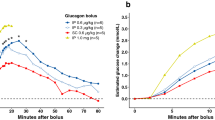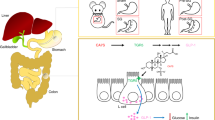Abstract
Direct intragastric delivery of a diet, nutrient or test substance can be achieved in rodents (mice and rats) on a long-term (2–3 months) basis using a chronically implanted gastrostomy catheter and a flow-through swivel system. This rodent intragastric infusion (iG) model has broad applications in research on food intake, gastrointestinal (GI) physiology, GI neuroendocrinology, drug metabolism and toxicity, obesity and liver disease. It achieves maximal control over the rate and pattern of delivery and it can be combined with normal ad libitum feeding of solid diet if so desired. It may be adopted to achieve infusion at other sites of the GI system to test the role of a bypassed GI segment in neuroendocrine physiology, and its use in genetic mouse models facilitates the genetic analysis of a central question under investigation.
This is a preview of subscription content, access via your institution
Access options
Subscribe to this journal
Receive 12 print issues and online access
$259.00 per year
only $21.58 per issue
Buy this article
- Purchase on SpringerLink
- Instant access to full article PDF
Prices may be subject to local taxes which are calculated during checkout



Similar content being viewed by others
References
Tsukamoto, H., Delgado, G., Reidelberger, R.D. & Largman, C. Effects of cholecystokinin, food intake and cephalic stimuli on plasma levels of amylase, lipase, and immunoreactive cationic trypsinogen in rats. Digestion 35, 69–77 (1986).
Colomb, V. et al. Route of nutrient delivery affects insulin sensitivity and liver glucose transporter expression in rat. Am. J. Physiol. 269, E827–E833 (1995).
Sclafani, A. & Glendinning, J.I. Sugar and fat conditioned flavor preferences in C57BL/6J and 129 mice: oral and postoral interactions. Am. J. Physiol. Regul. Integr. Comp. Physiol. 289, R712–R720 (2005).
de Araujo, I.E. et al. Food reward in the absence of taste receptor signaling. Neuron 57, 930–941 (2008).
Schier, L.A., Davidson, T.L. & Powley, T.L. Ongoing ingestive behavior is rapidly suppressed by a preabsorptive, intestinal 'bitter taste' cue. Am. J. Physiol. Regul. Integr. Comp. Physiol. 301, R1557–R1568 (2011).
Zukerman, S., Ackroff, K. & Sclafani, A. Rapid post-oral stimulation of intake and flavor conditioning by glucose and fat in the mouse. Am. J. Physiol. Regul. Integr. Comp. Physiol. 301, R1635–R1647 (2011).
Sclafani, A., Glass, D.S., Margolskee, R.F. & Glendinning, J.I. Gut T1R3 sweet taste receptors do not mediate sucrose-conditioned flavor preferences in mice. Am. J. Physiol. Regul. Integr. Comp. Physiol. 299, R1643–R1650 (2010).
Reidelberger, R.D., Heimann, D., Kelsey, L. & Hulce, M. Effects of peripheral CCK receptor blockade on feeding responses to duodenal nutrient infusions in rats. Am. J. Physiol. Regul. Integr. Comp. Physiol. 284, R389–R398 (2003).
Reidelberger, R.D. et al. Amylin receptor blockade stimulates food intake in rats. Am. J. Physiol. Regul. Integr. Comp. Physiol. 287, R568–R574 (2004).
Tsukamoto, H. et al. Severe and progressive steatosis and focal necrosis in rat liver induced by continuous intragastric infusion of ethanol and low fat diet. Hepatology 5, 224–232 (1985).
Tsukamoto, H., Towner, S.J., Ciofalo, L.M. & French, S.W. Ethanol-induced liver fibrosis in rats fed high fat diet. Hepatology 6, 814–822 (1986).
Tsukamoto, H. et al. Induction of liver cirrhosis in rats fed alcohol and iron. J. Clin. Invest. 96, 620–630 (1995).
Mathurin, P. et al. Exacerbation of alcoholic liver injury by enteral endotoxin in rats. Hepatology 32, 1008–1017 (2000).
Tsukamoto, H. Animal models of alcoholic liver injury. Clin. Liver Dis. 2, 739–751 (1998).
Clark, J.M., Brancati, F.L. & Diehl, A.M. Nonalcoholic fatty liver disease. Gastroenterology 122, 1649–1657 (2002).
Pelleymounter, M.A. et al. Effects of the obese gene product on body weight regulation in ob/ob mice. Science 269, 540–543 (1995).
Chen, H. et al. Evidence that the diabetes gene encodes the leptin receptor: identification of a mutation in the leptin receptor gene in db/db mice. Cell 84, 491–495 (1996).
Costet, P. et al. Peroxisome proliferator-activated receptor alpha-isoform deficiency leads to progressive dyslipidemia with sexually dimorphic obesity and steatosis. J. Biol. Chem. 273, 29577–29585 (1998).
Fan, C.Y. et al. Steatohepatitis, spontaneous peroxisome proliferation and liver tumors in mice lacking peroxisomal fatty acyl-CoA oxidase. Implications for peroxisome proliferator-activated receptor alpha natural ligand metabolism. J. Biol. Chem. 273, 15639–15645 (1998).
Lu, S.C. et al. Methionine adenosyltransferase 1A knockout mice are predisposed to liver injury and exhibit increased expression of genes involved in proliferation. Proc. Natl. Acad. Sci. USA 98, 5560–5565 (2001).
Horie, Y. et al. Hepatocyte-specific Pten deficiency results in steatohepatitis and hepatocellular carcinomas. J. Clin. Invest. 113, 1774–1783 (2004).
Yu, S. et al. Adipocyte-specific gene expression and adipogenic steatosis in the mouse liver due to peroxisome proliferator-activated receptor γ1 (PPARγ1) overexpression. J. Biol. Chem. 278, 498–505 (2003).
Poulsom, R. Morphological changes of organs after sucrose or fructose feeding. Prog. Biochem. Pharmacol. 21, 104–134 (1986).
Surwit, R.S. et al. Differential effects of fat and sucrose on the development of obesity and diabetes in C57BL/6J and A/J mice. Metabolism 44, 645–651 (1995).
Deng, Q.G. et al. Steatohepatitis induced by intragastric overfeeding in mice. Hepatology 42, 905–914 (2005).
Tsukamoto, H., Mkrtchyan, H. & Dynnyk, A. Intragastric ethanol infusion model in rodents. Methods Mol. Biol. 447, 33–48 (2008).
Acknowledgements
We are grateful for the technical support provided by all animal core personnel in the past. This work was supported by a P50 center grant from the US National Institute on Alcohol Abuse and Alcoholism (P50AA011999), other US National Institutes of Health grants (U01AA018663, R24AA012885) and the Medical Research Service of the US Department of Veterans Affairs. P.-Y.W. is a visiting scholar from the Department of Isotope Application, Institute of Nuclear Energy Research, Taiwan, Republic of China.
Author information
Authors and Affiliations
Contributions
A.U., R.H. and R.L. contributed to generating the data presented, creating figures and tables, and drafting the methods portion of the manuscript. P.-Y.W. contributed to assembly of the results and generation of figures. K.M. contributed his findings on alcohol and HCV interactions. H.T. who is an original developer of the rodent iG model contributed to the generation and assembly of figures and tables, and to the completion of the manuscript through supervision of others.
Corresponding author
Ethics declarations
Competing interests
The authors declare no competing financial interests.
Rights and permissions
About this article
Cite this article
Ueno, A., Lazaro, R., Wang, PY. et al. Mouse intragastric infusion (iG) model. Nat Protoc 7, 771–781 (2012). https://doi.org/10.1038/nprot.2012.014
Published:
Issue Date:
DOI: https://doi.org/10.1038/nprot.2012.014



